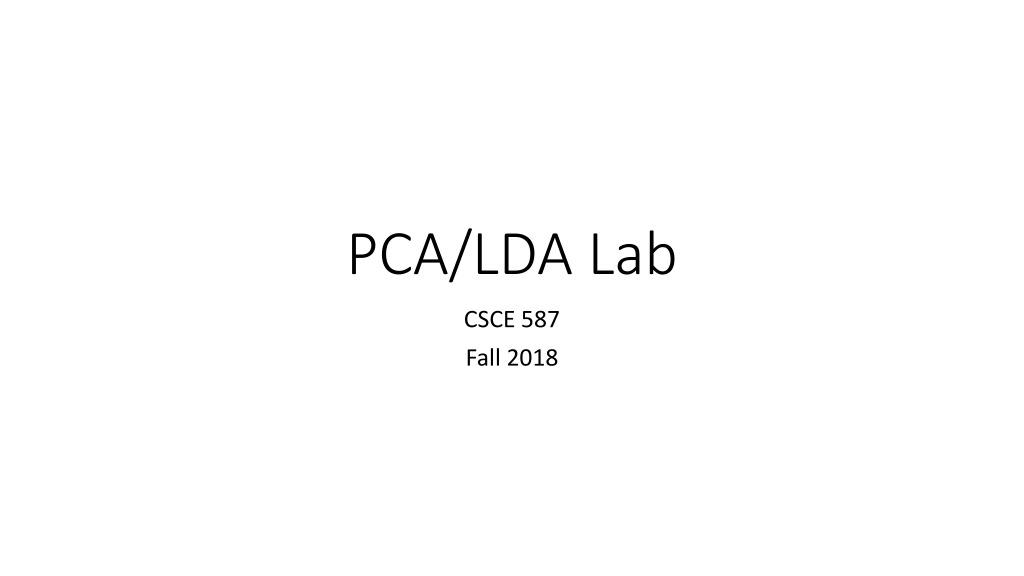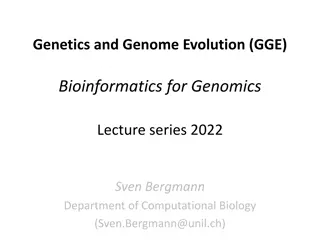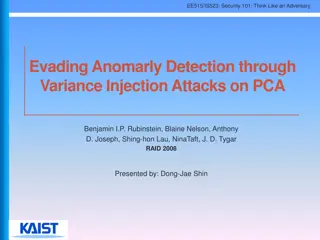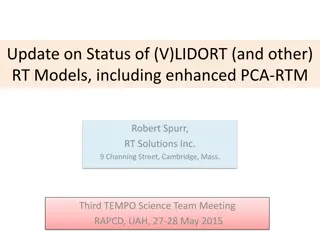PCA/LDA Lab
This lab focuses on exploring the concepts of Principal Component Analysis (PCA) and Linear Discriminant Analysis (LDA) using the iris dataset. It covers step-by-step instructions on performing PCA to extract independent variables, generating principal components, calculating variance, plotting components, and color-coding by species. Additionally, it demonstrates how to use tools like ggplot2 and ggfortify for visualization. The lab also introduces Linear Discriminant Analysis (LDA) with LFDA package, including creating the LDA model with independent and dependent variables. It serves as a practical guide for gaining hands-on experience with these analytical techniques.
Uploaded on Feb 17, 2025 | 0 Views
Download Presentation

Please find below an Image/Link to download the presentation.
The content on the website is provided AS IS for your information and personal use only. It may not be sold, licensed, or shared on other websites without obtaining consent from the author.If you encounter any issues during the download, it is possible that the publisher has removed the file from their server.
You are allowed to download the files provided on this website for personal or commercial use, subject to the condition that they are used lawfully. All files are the property of their respective owners.
The content on the website is provided AS IS for your information and personal use only. It may not be sold, licensed, or shared on other websites without obtaining consent from the author.
E N D
Presentation Transcript
PCA/LDA Lab CSCE 587 Fall 2018
PCA/LDA Lab # PCA & LDA Lab # We will need the following packages: # stats # ggplot2 # ggfortify # lfda # stats is already installed and loaded # The others should already be installed and only need to loaded.
PCA ############################################################ # example iris data # PCA # extract the independent variables iris_data <- iris[,-5] # generate the PCs iris_pca <- prcomp(iris_data, center = TRUE, scale. = TRUE) # Display the PCA object print(iris_pca)
PCA # convert from SD to var tot_var <- sum(sapply(iris_pca$sdev,function(x) x*x)) # get percent var pct_var <- sapply(iris_pca$sdev,function(x) x*x/tot_var) #plot percent var plot(pct_var, type="l")
PCA # first two PCs account for most of the variance sum(pct_var[1:2]) # plot the first two principal components # you can use autoplot to plot the first two PCs # use the work-around plot command autoplot(prcomp(iris_data, center = TRUE, scale. = TRUE)) # ugly version of plot plot(prcomp(iris_data, center = TRUE, scale. = TRUE)$x[,1:2])
PCA # plot the first two principal components and color by species # pretty autoplot autoplot(prcomp(iris_data, center = TRUE, scale. = TRUE), data = iris, colour = 'Species') # ugly standard R plot(prcomp(iris_data , center = TRUE, scale. = TRUE)$x[,1:2], col=iris[,5]) # plot the first two principal using autoplot from ggfortify # components, color by species, and label by observation index autoplot(prcomp(iris_data , center = TRUE, scale. = TRUE), data = iris, colour = 'Species', label = TRUE, label.size = 3)
ggfortify plots for our PCA example # plot the first two PCs and draw # the eigenvectors and label the loadings autoplot(prcomp(iris_data , center = TRUE, scale. = TRUE), data = iris, colour = 'Species', loadings = TRUE, loadings.colour = 'blue',loadings.label = TRUE, loadings.label.size = 3)
LDA using the lfda package ########################################################## # # Create the LDA model. The first argument is the set of 4 # independent variables. # The second argument is the dependent variable. # The third argument is the dimensionality of the reduced space # The fourth argument is the type of metric in the embedding space # iris_LDA <- lfda(iris_data, iris[, 5], r = 2, metric="plain")
LDA using the lfda package # plot the model autoplot(iris_LDA, data = iris, frame = TRUE, frame.colour = 'Species') # # plot the model and color the data by class # autoplot(iris_LDA, data = iris, colour="Species", frame = TRUE, frame.colour = 'Species')
LDA from MASS package # Create a data frame for the iris dataset Iris <- data.frame(rbind(iris3[,,1], iris3[,,2], iris3[,,3]),Sp = rep(c("s","c","v"), rep(50,3))) # Decide which observations a comprise the training set set.seed(587) train <- sample(1:150, 75) # Display the class membership of the training data set table(Iris$Sp[train])
LDA from MASS package # create the LDA model # Formula: SP ~., i.e. Sp is the classification and the other columns # are the independant data # Iris is the data set # prior = c(1,1,1)/3 even priors # subset: which observations are used to train with z <- lda(Sp ~ ., Iris, prior = c(1,1,1)/3, subset = train)
LDA from MASS package # Project from 4 iris dimensions onto the dimension of the first eigenvector # Note: this maps all 150 flowers iris_x <- (z$scaling[,1]) %*% t(iris[,-5]) # Project from 4 iris dimensions onto the dimension of the second eigenvector # Note: this maps all 150 flowers iris_y <- (z$scaling[,2]) %*% t(iris[,-5])
LDA from MASS package # plot 150 iris data points plot(iris_y~iris_x) # plot 150 iris data points & color by species plot(iris_y~iris_x, col=iris[,5])
table(Original=Iris[test,]$Sp, predict(z,Iris[test,])$class) # Create indices for a test set (use the observations NOT in the training set) test <- c(1:150)[-train] # classify the test set and display as a confusion matrix table(Original=Iris[test,]$Sp, predict(z, Iris[test,])$class)
More difficult PCA example ############################################################## # PCA example using icu data from earlier in the semester tmp <- icu[,-c(1, 2)] pca_tmp <- prcomp(tmp, center = TRUE, scale. = TRUE) print(pca_tmp) plot(pca_tmp, type="l") tot_var <- sum(sapply(pca_tmp$sdev,function(x) x*x))
More difficult PCA example pct_var <- sapply(pca_tmp$sdev,function(x) x*x/tot_var) plot(pct_var, type="l") sum(pct_var[1:10]) # autoplot autoplot(prcomp(tmp, center = TRUE, scale. = TRUE)) #regular plot plot(prcomp(tmp , center = TRUE, scale. = TRUE)$x[,1:2]) # autoplot autoplot(prcomp(tmp , center = TRUE, scale. = TRUE ), data = icu, colour = 'STA') # regular plot plot(prcomp(tmp , center = TRUE, scale. = TRUE)$x[,1:2], col=icu[,2]+1)
More difficult LDA example # Find linear discriminants icu_LDA <- lfda(icu[,-c(1:2)], icu[, 2], r = 2, metric="plain") # Plot classification autoplot(icu_LDA, data=icu, colour="STA", frame=TRUE, frame.colour='STA')

























